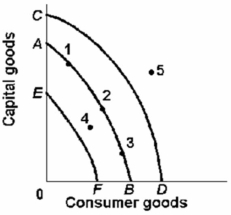A) 3 percent.
B) 5 percent.
C) 7 percent.
D) 9 percent.
Correct Answer

verified
Correct Answer
verified
Multiple Choice
The average living standards in Canada compared to Africa are much higher because:
A) the economic growth has occurred for nearly two centuries in Africa compared to a few decades in Canada.
B) the economic growth has occurred for nearly two centuries in Canada compared to more than two centuries in Africa.
C) the economic growth differences have no relationship to the differences in the average standards of living.
D) the economic growth has occurred for nearly two centuries in Canada compared to a few decades in Africa.
Correct Answer

verified
Correct Answer
verified
Multiple Choice
Economic growth is best defined as an increase in:
A) either real GDP or real GDP per capita.
B) nominal GDP.
C) total consumption expenditures.
D) wealth in the economy.
Correct Answer

verified
Correct Answer
verified
Multiple Choice
Between 1946 - 2011,the annual Canadian multifactor productivity has increased by about:
A) 4%
B) 2%
C) 5%
D) 7%
Correct Answer

verified
Correct Answer
verified
Multiple Choice
Do the recent high technological advances and productivity rates mean that the business cycle is dead?
A) Yes,the faster rate of productivity growth will eliminate recession.
B) Yes,the changes in technology have a compound,positive effect on the economy.
C) No,the trend line for economic growth is just steeper,but there can still be economic downturns.
D) No,the fact there are many start-up firms means that there will be more bankruptcies that will hurt the economy.
Correct Answer

verified
Correct Answer
verified
Multiple Choice
Which is an efficiency factor in economic growth?
A) an efficient allocation of resources
B) natural resources
C) the quantity and quality of labour
D) technological knowledge
Correct Answer

verified
Correct Answer
verified
True/False
Critics of economic growth say that it will deplete economic resources.
Correct Answer

verified
Correct Answer
verified
Multiple Choice
During the last decade,the innovations in computers and telecommunications,together with global competition,have resulted in:
A) rational expectations theory.
B) lower growth in capital stock.
C) higher growth in labour force.
D) higher productivity growth.
Correct Answer

verified
Correct Answer
verified
Multiple Choice
Labour productivity may best be defined as:
A) total output/worker-hours.
B) nominal GDP minus real GDP.
C) the ratio of real capital to worker-hours.
D) the annual increase in nominal GDP per worker.
Correct Answer

verified
Correct Answer
verified
True/False
Simultaneous consumption is a source of increasing returns and economies of scale.
Correct Answer

verified
Correct Answer
verified
Multiple Choice
Nominal GDP was $9,500 billion in Year 1 and $10,000 billion in Year 2.The GDP price index was 170 in Year 1 and 175 in Year 2.Between Years 1 and 2,the rate of growth in real GDP was approximately:
A) 1.6 percent.
B) 2.3 percent.
C) 4.4 percent.
D) 5.3 percent.
Correct Answer

verified
Correct Answer
verified
True/False
In Canada,real GDP per capita has increased more rapidly than real GDP.
Correct Answer

verified
Correct Answer
verified
True/False
An increase in the quantity and quality of natural resources is a demand factor for economic growth.
Correct Answer

verified
Correct Answer
verified
Multiple Choice
The knowledge and skill that make for a productive worker are referred to by economists as:
A) human capital.
B) increasing returns.
C) resource allocation.
D) simultaneous consumption.
Correct Answer

verified
Correct Answer
verified
Multiple Choice
Between 1945 - 2011,the labour force in Canada has increased by about:
A) 13.5 million workers.
B) 18 million workers.
C) 4.5 million workers.
D) 15 million workers.
Correct Answer

verified
Correct Answer
verified
Multiple Choice
 -Refer to the above diagram.If the production possibilities curve of an economy shifts from AB to CD,it is most likely the result of what factor affecting economic growth?
-Refer to the above diagram.If the production possibilities curve of an economy shifts from AB to CD,it is most likely the result of what factor affecting economic growth?
A) a supply factor
B) a demand factor
C) an efficiency factor
D) an allocation factor
Correct Answer

verified
Correct Answer
verified
Multiple Choice
Labour productivity is measured by:
A) the ratio of capital to labour.
B) real output per worker hour.
C) real output per capital.
D) the ratio of worker hours to nominal GDP.
Correct Answer

verified
Correct Answer
verified
Multiple Choice
The different starting dates for modern economic growth in different parts of the world are the main cause of:
A) today's small differences in per capita GDP levels around the world.
B) today's large differences in per capita GDP levels around the world.
C) today's small differences in nominal GDP levels around the world.
D) today's large differences in population levels around the world.
Correct Answer

verified
Correct Answer
verified
Multiple Choice
Critics of the recent rapid advances in new technology say that:
A) it is too early to predict whether recent boosts in Canadian productivity are permanent or transitory.
B) global competition is a media fiction,not an economic reality.
C) the growth of service productivity is severely understated.
D) many of the factors slowing productivity in the past have now reversed themselves.
Correct Answer

verified
Correct Answer
verified
Multiple Choice
If an economy's real GDP doubles in fourteen years,then the average annual rate of growth in real GDP is about:
A) 3 percent.
B) 4 percent.
C) 5 percent.
D) 6 percent.
Correct Answer

verified
Correct Answer
verified
Showing 61 - 80 of 112
Related Exams